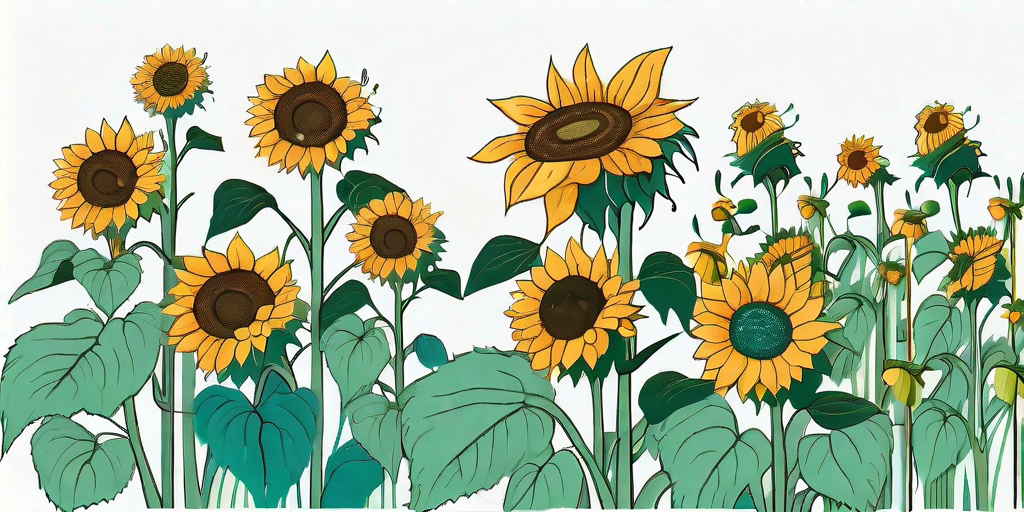
Sunflowers, with their bright yellow petals and towering stems, are the rockstars of the garden world. They're not just pretty faces, though. These late bloomers are hardy, easy to grow, and can provide a bountiful harvest of seeds. But how do you get from a tiny seed to a sunflower that's taller than your nosy neighbor's fence? Buckle up, green thumbs, because we're about to embark on a sunflower-growing journey.
The Basics of Sunflower Growing
Choosing the Right Variety
Before you can start planting, you need to choose the right variety of sunflower. There are over 70 different types of sunflowers, ranging from the classic giant sunflower to dwarf varieties that won't tower over your garden. Some sunflowers are grown for their seeds, while others are grown for their ornamental value. Choose a variety that suits your garden and your goals.
For those of you looking to harvest seeds, the 'Russian Giant' and 'Mammoth' varieties are your best bet. If you're more interested in aesthetics, 'Teddy Bear' and 'Moulin Rouge' offer unique and eye-catching blooms. And if you're short on space, 'Pacino' and 'Elf' are compact varieties that won't take over your garden.
When and Where to Plant
Timing is everything when it comes to planting sunflowers. These plants are heat-loving and frost-sensitive, so you'll want to plant them after the last frost of the spring. In most areas, this means planting in late April or early May.
As for where to plant, sunflowers aren't picky. They can grow in almost any type of soil, as long as it's well-draining. The most important thing is to choose a location that gets plenty of sun. After all, they're not called sunflowers for nothing!
Planting and Caring for Your Sunflowers
Planting Your Seeds
Now that you've chosen your variety and your planting location, it's time to get those seeds in the ground. Plant your seeds about 1 inch deep and 6 inches apart. If you're planting a giant variety, give them a little more elbow room and plant them 12 inches apart.
Water your seeds well after planting, and keep the soil moist until the seeds germinate. This usually takes about 7 to 10 days. After germination, water deeply but infrequently to encourage deep root growth.
Caring for Your Sunflowers
Sunflowers are pretty low-maintenance plants, but they do require some care. They need at least 6 hours of sun per day, so make sure they're not being shaded by other plants. They also prefer slightly acidic to neutral soil, so you may need to amend your soil depending on its pH.
While sunflowers are drought-tolerant, they'll perform best with regular watering. Aim for about 1 inch of water per week, either from rainfall or supplemental watering. And don't forget to stake your sunflowers if they're a tall variety. You don't want a gust of wind to snap your sunflower's stem before it's had a chance to bloom.
Harvesting and Using Your Sunflowers
Harvesting Your Sunflowers
Harvesting sunflowers is a bit like playing a game of chicken. You want to wait until the back of the sunflower head turns brown, but you also need to beat the birds and squirrels to the punch. Once the back of the head is brown and the petals have fallen off, cut the head off with a sharp knife or pair of pruners.
After you've harvested the head, you'll need to dry it out before you can extract the seeds. Hang the heads in a dry, well-ventilated area for a few weeks until the seeds are easy to remove.
Using Your Sunflowers
Sunflower seeds are a tasty and nutritious snack, but that's not the only way you can use your sunflowers. The seeds can also be used to make sunflower oil or sunflower butter. And don't forget about the flowers themselves. Sunflowers make stunning cut flowers and can be dried for long-lasting arrangements.
FAQs
Why aren't my sunflowers blooming?
There could be a few reasons why your sunflowers aren't blooming. They might not be getting enough sun, or they might be planted too closely together. It's also possible that they're not blooming yet because they're a late-blooming variety. Be patient, and give your sunflowers the care they need, and they should bloom in time.
Can I grow sunflowers in pots?
Absolutely! While sunflowers typically prefer to spread their roots in the ground, they can be grown in pots. Just make sure to choose a dwarf variety and a pot that's large enough to accommodate the sunflower's root system.
Do sunflowers need a lot of water?
Sunflowers are drought-tolerant and can survive with little water, but they'll perform best with regular watering. Aim for about 1 inch of water per week, either from rainfall or supplemental watering.
Conclusion
There you have it, folks. The ins and outs of growing sunflowers. From choosing the right variety to harvesting your sunflowers, we've covered it all. Now it's time for you to roll up your sleeves, get your hands dirty, and start planting. Happy gardening!















